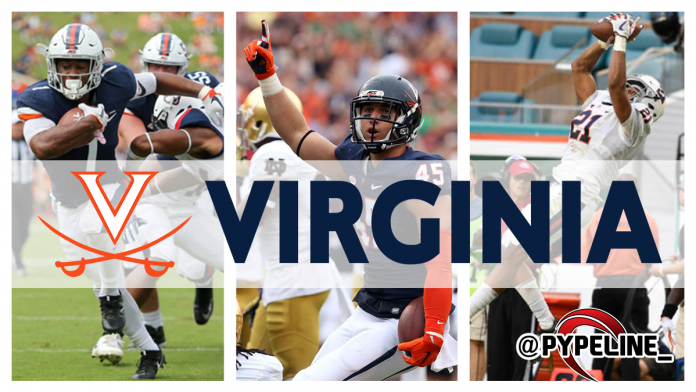At the conclusion of Bronco Mendenhall’s first season as Virginia head coach in 2016, the Cavaliers’ football program was in a downward spiral. With a 2–10 overall record and just one victory in ACC play, UVA suffered its fifth consecutive losing season. As a result, they failed to qualify for postseason play for the first time since 2011. However, things changed drastically in 2017. The Cavaliers got off to a blistering start at 5–1, including a road thrashing of G5 power Boise State, thanks to their ascendant offense and some good fortunes.
And then the wheels fell off again.
The Wahoos lost six of their last seven games, each one coming by double digits. The offense sputtered and the defense faltered, culminating in the season-ending blowout against Navy in the Military Bowl. Not to be lost in the disappointing finish, however, was the fact that for the first time in years, it felt as though the UVA football program was finally taking a step in the right direction. Now, Coach Mendenhall faces a vexing question. With heavy turnover from last year’s team, can he sustain the progress made in his second season in Charlottesville? If he is to do so, it starts with finding a new signal-caller.

Offense
The most important position on any football team is the quarterback. Virginia will see a new face under center in 2018. Gone is the former East Carolina transfer Kurt Benkert, who in just two seasons threw for nearly 6,000 yards and 46 touchdowns. It’s a shame for Cavalier fans to see him depart, as Benkert really turned on the jets halfway through the year. In nine games from September 16th to November 18th, the senior threw for 2,355 yards with a 21/8 TD/INT ratio and a 134.8 passer rating. But he must be replaced, and the candidate to do so is JUCO transfer Bryce Perkins.
Perkins began his career at Arizona State in 2015, but suffered a neck injury causing him to miss the entire 2016 season. He then transferred to Arizona Western Community College, and has now taken his talents to Charlottesville. Since Perkins has no NCAA stats of which to speak, the best we can do is speculate how he will impact the offense. He is not a downfield passer like the pro-style Benkert. Instead, he will likely look to pick up yards running. The Cavs will run a true read-option, so it will be intriguing to see how the players adapt to the system. Expect some growing pains early on.
Running Game
In 2017, Virginia finished dead last in the ACC in total rushing yards, rushing attempts, and yards per carry. Understand that with Benkert’s strong arm, they ran an air raid offense similar to (but not quite as extreme as) Washington State with passing guru Mike Leach. This will surely change in 2018. Senior Jordan Ellis returns, having lead last year’s squad with 836 rushing yards and six touchdowns. But his 3.9 ypc average must increase. Also returning is fellow senior Olamide Zaccheaus, who is as speedy as his 5’8 stature might suggest. Zaccheaus was used mostly as a receiver. However, he should see more carries with UVA’s new ground-happy offense. The only question is who will step up to be the workhouse. Perkins’ ability to run as quarterback helps in this regard.
Of course, much of the Cavaliers’ success on the ground hinges on the play of the offensive line. Both starting tackles and one guard all graduated. The Hoos have added Rutgers transfer Marcus Applefield, who can play guard or tackle. Back is senior Jake Fieler, who started all 13 games last season: four at center and nine at RG. Redshirt sophomore Dillon Reinkensmeyer projects to be the starting center. It’s a unit that saw improved play in 2017, cutting down on sacks allowed by 0.6 per game from the previous season. But three new faces and positional changes would suggest that it will take some time to develop chemistry.

Receivers
UVA will have to replace two of their top three leading receivers from a season ago. Seniors Andre Levrone and Doni Dowling both graduated. Levrone was the one of the few deep threats on the squad. He led the team in both receiving touchdowns (7) and yards per catch (20.3). Tight end Evan Butts is expected to get more touches. He had a breakout junior campaign in which he 32 passes for 266 yards in just 11 games. Perhaps most intriguing of all is junior Joe Reed. His play at wideout was inconsistent in 2017, but he showed flashes of potential. Reed also doubles as an excellent kick returner—his 27.9-yard average on kick returns was best in the ACC. Along with senior Jordan Ellis, the Hoos receiving corps has much to prove. And with a new quarterback under center, the offense may be slow to start.
Defense
The Cavaliers’ defense was surprisingly stout for most of last year, but they lost several key pieces, namely All-American linebacker Micah Kiser and safety Quin Blanding, who led the team in tackles. On the defensive line, junior nosetackle Eli Hanback, who had 5.5 TFLs and 1.5 sacks in 2017, returns with the most experience. It will be a youth movement for the most part, however. Sophomore DE Mandy Alonso saw action in five games and recorded 14 tackles, and the Hoos managed to get Ohio State transfer Dylan Thompson, as well as JUCO transfer Cassius Peat.
Linebackers
Linebackers are usually the strength of Bronco Mendenhall’s defense. Kiser’s departure will be felt, but almost everyone else is returning, and the field is diverse. Seniors Chris Pearce (10.5 TFL, 7.5 sacks) and Malcom Cook (46 tackles, 4.0 TFL) are back. So are juniors Jordan Mack, the leading returning tackler with 114 stops, and Chris Moore. This linebacking unit will shape up to be the heart and soul of Virginia football in 2018.
Secondary
Juan Thornhill will return at strong safety and his presence should greatly impact the rest of the secondary. Thornhill was All-ACC Third Team in his junior campaign, and recorded 63 tackles and 4.5 TFL last season. He has recorded seven interceptions the last two seasons combined, along with 19 passes defended (his 12 PDs a year ago ranked fourth in the ACC).
Cornerback Tim Harris is an interesting case: he was a prized recruit under Mike London, and has been on the team since 2013. But a shoulder injury in September of 2016 and a wrist injury the very next year have limited him to just two games in the last two seasons. If he can stay healthy, he will be a valuable asset at corner, possibly alongside Myles Robinson. Junior Bryce Hall will also be in the mix, with 8 PDs and one pick a season ago. Brenton Nelson, after a breakout freshman season, is a prime candidate to replace Blanding at safety.

Prediction
The Cavaliers return significant production from a linebacking and secondary unit that was very solid in 2017. This should bode well for the defense, even if the depth and experience on the defensive line is thin. While they do return several pieces on the offense as well, the unit as a whole simply wasn’t good enough to expect any meteoric rise. Adding to the troubles is having to replace three offensive linemen with a new quarterback and modified offensive system, and we have every reason to think the Hoos will struggle to put points on the board.
The reality is that Virginia exceeded expectations in 2017, even for a team that went 6–7. They won three ACC games by seven points or less, and lost by 17 points or more five times. We would expect them to regress this season, and FPI projects them to win just three games. But the preseason is the time for eternal optimism, and if the Cavaliers can capitalize on the close-score luck they had a year ago, they could find themselves contending for a bowl berth. To do so, they will likely need to beat Indiana (Sep. 8) on the road, while upsetting North Carolina (Oct. 27) and Pittsburgh (Nov. 2) at home. But they have a favorable non-conference schedule with match-ups against FCS Richmond, Ohio, and Liberty.
Prediction: 5-7 (2-6 ACC), 6th in Coastal Division






